Special Report
These Are the 50 Places You're Most Likely to Catch Lyme Disease
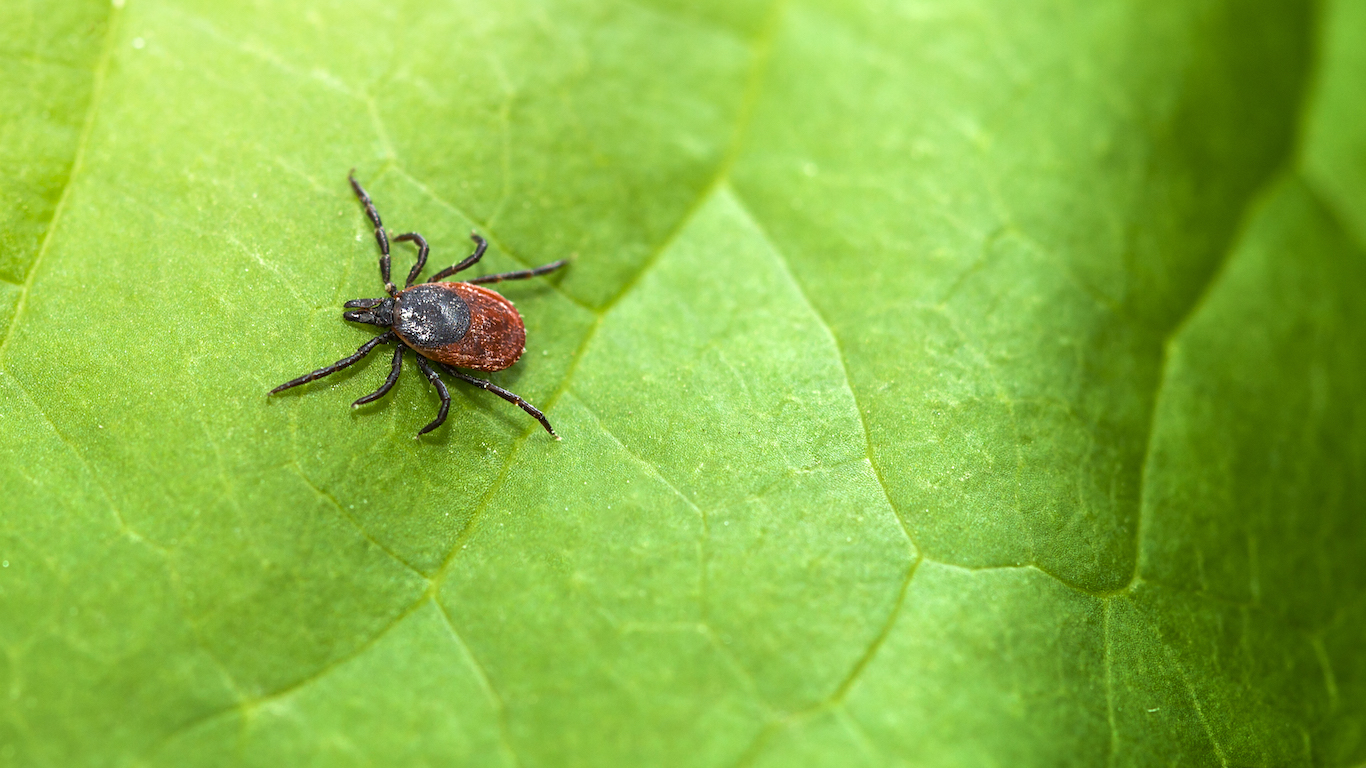
Published:

Spending as much time as possible outdoors has become synonymous with staying healthy, especially in the age of COVID-19 (as Americans are being urged to exercise out in the open air to prevent infection-optional). But the risk for exposure to vector-borne diseases caused by bug bites may increase.
Mosquitoes, fleas, and ticks can spread viruses and bacteria, including Zika, bubonic plague, and Lyme disease. Here are some dangerous bug bites to watch out for in the summer.
Of all tick-borne diseases in the United States, Lyme disease is the most prevalent. According to a 2018 study released by the Centers for Disease Control and Prevention, cases of tick-borne disease in the U.S. and its territories more than doubled from 2004 to 2016, with Lyme disease making up 82% of these cases.
Lyme disease is a bacterial infection spread by western black-legged ticks on the Pacific coast and deer ticks in the rest of the country. The ticks tend to inhabit wooded areas and long grasses. If left untreated, Lyme disease can cause an array of symptoms, including arthritis, facial paralysis, and nerve pain.
Using data from the CDC, 24/7 Tempo compiled the 50 worst counties for Lyme disease in the U.S. Cases of Lyme disease are most prevalent in the Northeast, the mid-Atlantic, and the Midwest.
Ticks generally must be attached for at least 36 hours in order for the bacterium to spread. In most cases, transmission happens through the bites of tiny (less than 2mm), immature nymphs that go undetected on the skin.
Nymphs feed during spring and summer, so extra precautions should be taken when outdoors during these times. Precautions include wearing insect repellents, treating clothing and gear with permethrin, and inspecting your body and clothing for ticks after spending time outdoors. Here are 16 tips for preventing coronavirus and other viral infections.
Click here to see the 50 worst counties for lyme disease
To identify the 50 worst counties for Lyme disease, 24/7 Tempo reviewed the number of Lyme disease cases reported between 2014 and 2018 for every 10,000 people in the 3,143 counties tracked by the Centers for Disease Control and Prevention, National Center for Emerging and Zoonotic Infectious Diseases (NCEZID), Division of Vector-Borne Diseases (DVBD).
Population data was obtained from the U.S. Census Bureau’s 2018 American Community Survey and are 5-year averages.
50. Grand Isle County, Vermont
> Lyme disease cases 5 years through 2018 per 10,000 people: 78
> Lyme disease cases 5 years through 2018: 54
> Worst year for Lyme disease since 2000: 14 in 2017
> Total population: 6,965
Composed of multiple islands in Lake Champlain in Vermont, Grand Isle County is a partially forested area with a relatively small population. According to data going back to 2000, the county didn’t start to see multiple Lyme disease cases per year until 2008, with cases generally increasing until a peak in 2017, when the county recorded 14 cases.
[in-text-ad]

49. Kennebec County, Maine
> Lyme disease cases 5 years through 2018 per 10,000 people: 78
> Lyme disease cases 5 years through 2018: 943
> Worst year for Lyme disease since 2000: 266 in 2017
> Total population: 121,545
Of the six counties in Maine that rank among the worst counties for Lyme disease, Kennebec County has the largest population by far. It has recorded 1,786 cases of Lyme disease since 2000 — a higher total than any of the six worst counties. As with many counties in the Northeast, cases increased sharply in 2008 and peaked in 2017.

48. Menominee County, Wisconsin
> Lyme disease cases 5 years through 2018 per 10,000 people: 81
> Lyme disease cases 5 years through 2018: 37
> Worst year for Lyme disease since 2000: 13 in 2013
> Total population: 4,579
Menominee County, Wisconsin, has the smallest population of the 50 worst counties for Lyme disease. Although yearly Lyme disease infections are often in the single digits in the county, cases are still disproportionately high compared with the county’s population. Menominee contains over 223,000 acres of forested lands, which make up the state’s largest tract of uncut forest.
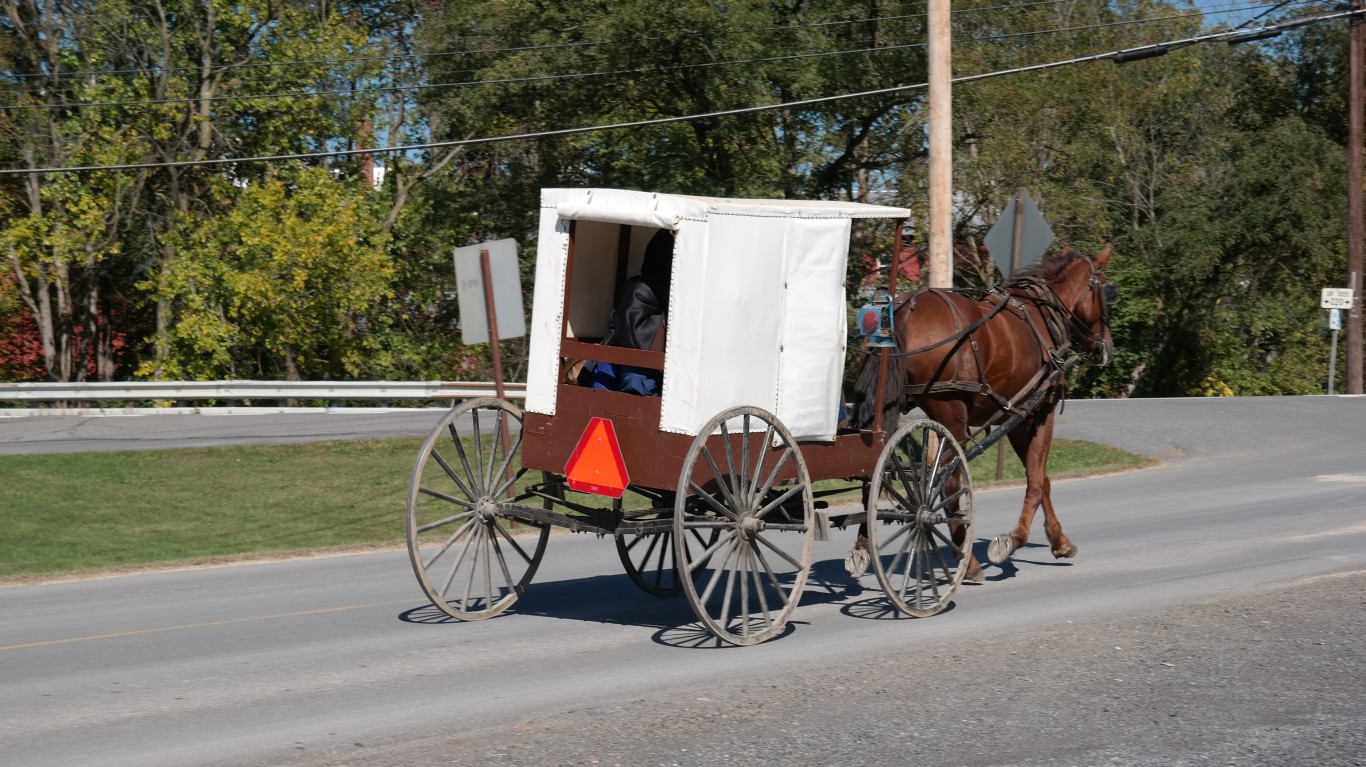
47. Mifflin County, Pennsylvania
> Lyme disease cases 5 years through 2018 per 10,000 people: 86
> Lyme disease cases 5 years through 2018: 399
> Worst year for Lyme disease since 2000: 104 in 2017
> Total population: 46,362
Pennsylvania has more counties, 22, than any other state that rank among the worst counties for Lyme disease. A surge in the deer tick population is to blame, although theories vary as to why the tick population is booming. Mifflin County runs along the Appalachian Mountains and has recorded a rise in Lyme cases from three in 2000 to 104 in 2017.
[in-text-ad-2]
46. Wayne County, Pennsylvania
> Lyme disease cases 5 years through 2018 per 10,000 people: 87
> Lyme disease cases 5 years through 2018: 446
> Worst year for Lyme disease since 2000: 113 in 2017
> Total population: 51,536
Wayne County, in the Poconos of Pennsylvania, has an abundance of lakes and forested areas. Lyme disease cases in the county remained under 20 annually until 2008 and didn’t top 100 until 2016, peaking at 113 in 2017.

45. Pine County, Minnesota
> Lyme disease cases 5 years through 2018 per 10,000 people: 87
> Lyme disease cases 5 years through 2018: 254
> Worst year for Lyme disease since 2000: 64 in 2017
> Total population: 29,129
Pine County in eastern Minnesota is home to multiple state parks and forests as well as lakes and rivers that attract outdoor enthusiasts. While many northeastern counties didn’t start recording Lyme disease until the mid-2000s, Pine County has had at least a dozen cases annually from 2000 to 2008, and averaged 49 cases annually from 2009 to 2018.
[in-text-ad]
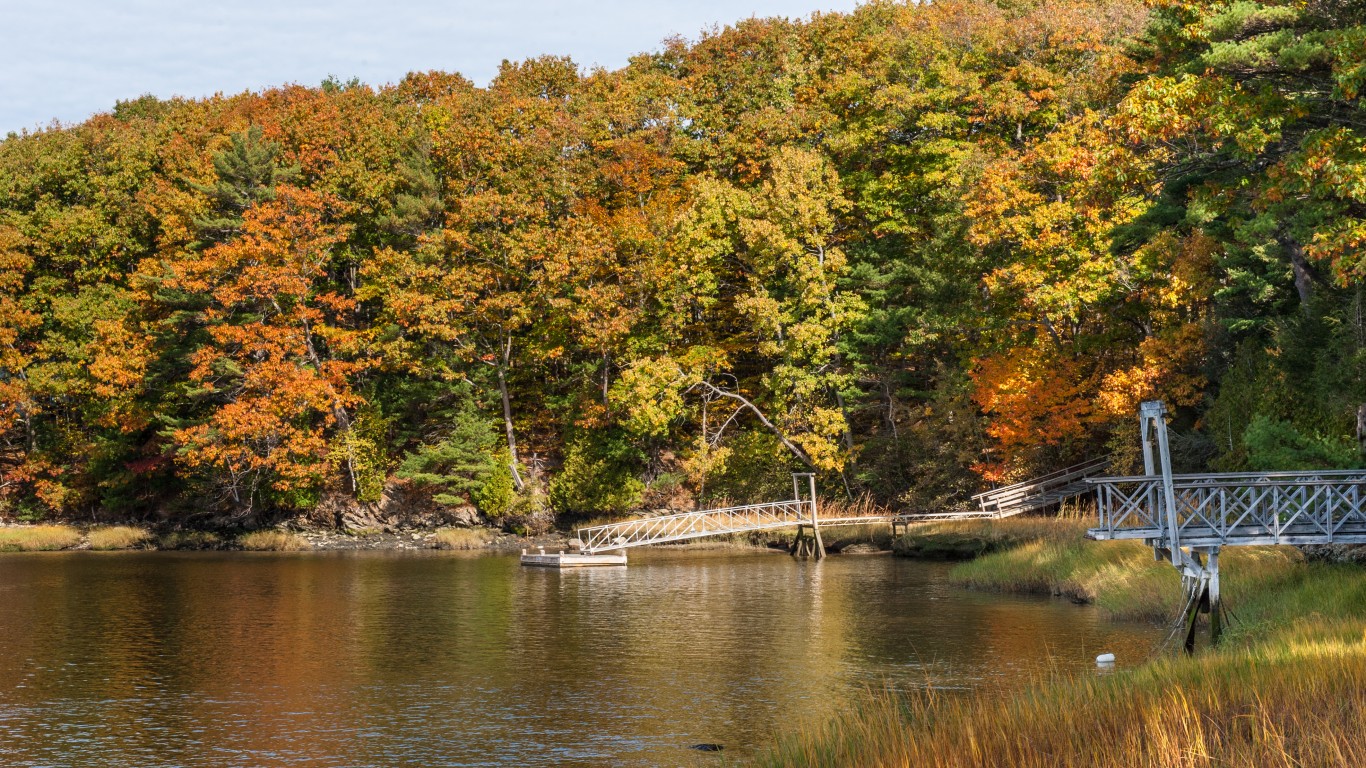
44. Sagadahoc County, Maine
> Lyme disease cases 5 years through 2018 per 10,000 people: 88
> Lyme disease cases 5 years through 2018: 311
> Worst year for Lyme disease since 2000: 91 in 2016
> Total population: 35,277
Sagadahoc, on the coast of Maine, has the smallest land area of any Maine county but the fifth highest rate of Lyme disease cases per capita in the state from 2014 to 2018. Cases peaked in 2016 at 91 recorded Lyme disease diagnoses.
43. Hubbard County, Minnesota
> Lyme disease cases 5 years through 2018 per 10,000 people: 88
> Lyme disease cases 5 years through 2018: 184
> Worst year for Lyme disease since 2000: 55 in 2011
> Total population: 20,862
Hubbard is a heavily forested county in northern Minnesota that consists of dozens of lakes and large swaths of state land, including the majority of the 105,116-acre Paul Bunyan State Forest. Although cases of Lyme disease in the county have never topped 55 per year, the cases per capita still rank among the worst in the state.
42. Crow Wing County, Minnesota
> Lyme disease cases 5 years through 2018 per 10,000 people: 89
> Lyme disease cases 5 years through 2018: 570
> Worst year for Lyme disease since 2000: 153 in 2016
> Total population: 63,855
Unlike many eastern U.S. counties, where cases didn’t start rising until the mid-late 2000s, the Midwestern county of Crow Wing, Minnesota, was already seeing Lyme disease cases in the dozens by 2000. Cases hit 149 in 2002. From 2000 to 2018, the county recorded a total of 1,882 cases of Lyme disease — more than in any other of the worst counties in the Midwestern hotspots of Minnesota and Wisconsin.
[in-text-ad-2]

41. Nantucket County, Massachusetts
> Lyme disease cases 5 years through 2018 per 10,000 people: 91
> Lyme disease cases 5 years through 2018: 101
> Worst year for Lyme disease since 2000: 67 in 2012
> Total population: 11,101
Nantucket County is the only Massachusetts county that ranks among the worst in the country for Lyme disease. With a population just over 11,000, the county recorded 719 Lyme disease cases from 2000 to 2018. That’s 648 cases per 10,000 people, the third-highest on a per capita basis during that span of years.
40. Sussex County, New Jersey
> Lyme disease cases 5 years through 2018 per 10,000 people: 99
> Lyme disease cases 5 years through 2018: 1,404
> Worst year for Lyme disease since 2000: 442 in 2011
> Total population: 142,298
Sussex County is one of the most heavily forested counties in New Jersey. From 2000 to 2018, the county in northwestern New Jersey recorded 5,696 cases of Lyme disease, peaking at 442 reported cases in 2011. Although cases were down to 246 in 2018, the county continues to rank as one of the worst counties for Lyme disease.
[in-text-ad]
39. Perry County, Pennsylvania
> Lyme disease cases 5 years through 2018 per 10,000 people: 102
> Lyme disease cases 5 years through 2018: 468
> Worst year for Lyme disease since 2000: 130 in 2016
> Total population: 45,924
Perry County, Pennsylvania, is a mountainous area that includes three state parks, a state forest, and a length of the Appalachian National Scenic Trail. The county also has a 1,259-acre plot of state game land reserved for hunting and other outdoor recreation. Until 2014, annual Lyme cases in the area didn’t exceed 37, but from 2016 to 2018 they topped 100 annually.

38. Waldo County, Maine
> Lyme disease cases 5 years through 2018 per 10,000 people: 102
> Lyme disease cases 5 years through 2018: 403
> Worst year for Lyme disease since 2000: 142 in 2017
> Total population: 39,418
Waldo County is one of five coastal Maine counties that rank among the 50 worst counties for Lyme disease. Cases in the county have remained under 100 most years since 2000, with the exception of 142 cases in 2017.
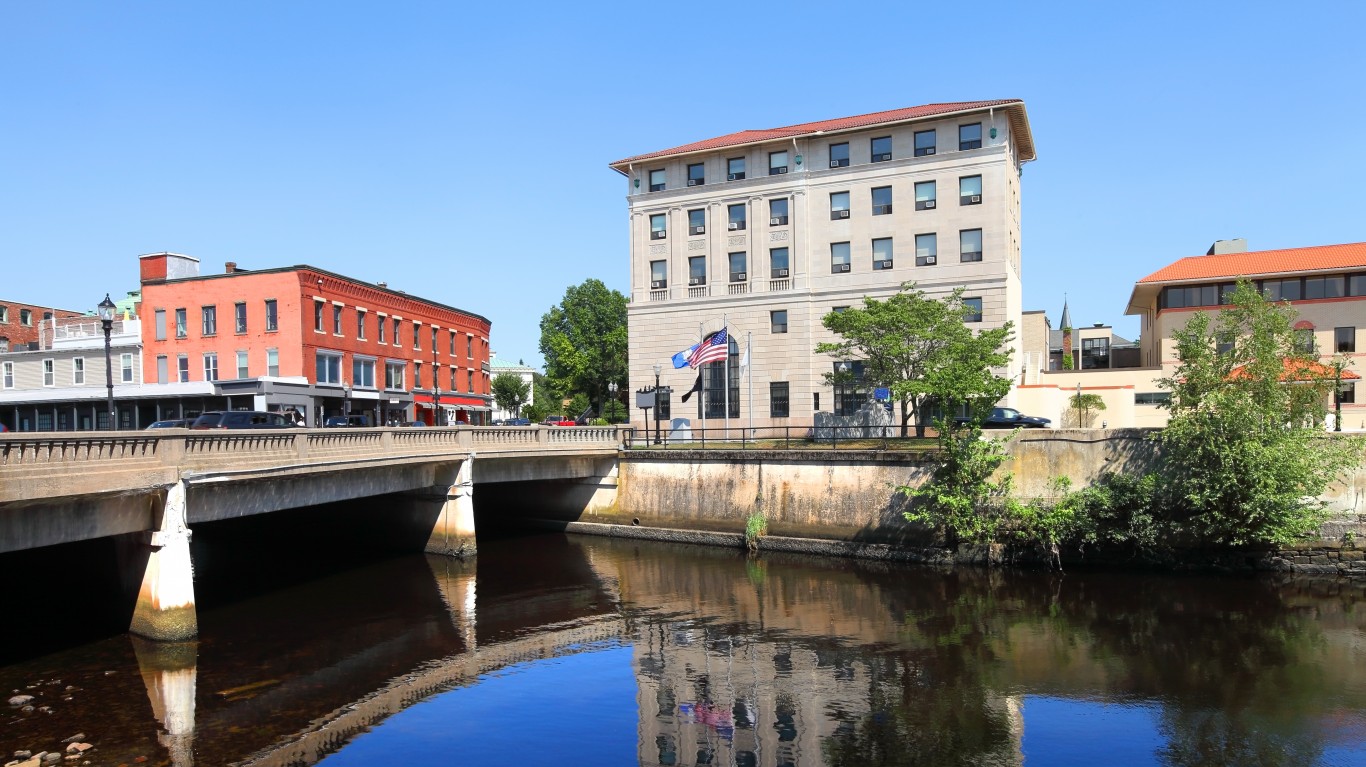
37. Washington County, Rhode Island
> Lyme disease cases 5 years through 2018 per 10,000 people: 102
> Lyme disease cases 5 years through 2018: 1,293
> Worst year for Lyme disease since 2000: 394 in 2002
> Total population: 126,242
Washington County is the only county in Rhode Island that ranks among the worst counties for Lyme disease. It has the third highest median household income among those counties, at $81,301 annually. According to the 2020 County Health Rankings, 92.2% of the population has access to exercise opportunities.
[in-text-ad-2]
36. Richland County, Wisconsin
> Lyme disease cases 5 years through 2018 per 10,000 people: 103
> Lyme disease cases 5 years through 2018: 180
> Worst year for Lyme disease since 2000: 65 in 2009
> Total population: 17,539
Richland County in southern Wisconsin is the third worst county in the state for Lyme disease. Although annual cases never topped 65 from 2000 to 2018, the county’s disease infection rate during that span was 330 per 10,000 people.
35. Sullivan County, Pennsylvania
> Lyme disease cases 5 years through 2018 per 10,000 people: 104
> Lyme disease cases 5 years through 2018: 64
> Worst year for Lyme disease since 2000: 18 in 2017
> Total population: 6,177
Sullivan County has the second smallest population of all Pennsylvania counties and the third smallest population of the 50 worst counties for Lyme disease. Although in most years between 2000 and 2013 the county recorded 0-2 cases, the average annual cases from 2014 to 2018 was 12.8.
[in-text-ad]
34. Marquette County, Wisconsin
> Lyme disease cases 5 years through 2018 per 10,000 people: 106
> Lyme disease cases 5 years through 2018: 161
> Worst year for Lyme disease since 2000: 76 in 2017
> Total population: 15,207
Cases of Lyme disease in Marquette County, Wisconsin, remained in the single digits from 2000 to 2006, and peaked at 76 cases in 2017, dropping back down to 11 cases in 2018. Marquette’s tourism bureau bills the county as a sportsman’s paradise, with prairies, lakes, and forests for a variety of outdoor enthusiasts.
33. Susquehanna County, Pennsylvania
> Lyme disease cases 5 years through 2018 per 10,000 people: 110
> Lyme disease cases 5 years through 2018: 454
> Worst year for Lyme disease since 2000: 129 in 2017
> Total population: 41,340
A mountainous region in northeastern Pennsylvania, Susquehanna County contains multiple lakes and rivers as well as a state park. It is one of Pennsylvania’s seven completely rural counties. Like multiple other eastern locales, Susquehanna saw a surge in Lyme cases in 2017, peaking at 129 cases, while in 2018 cases dropped to 74.
32. Potter County, Pennsylvania
> Lyme disease cases 5 years through 2018 per 10,000 people: 111
> Lyme disease cases 5 years through 2018: 188
> Worst year for Lyme disease since 2000: 49 in 2018
> Total population: 16,937
Potter County, Pennsylvania, is a heavily forested county that contains over 390 square miles of state forests and seven state parks. Lyme disease cases in the county increased every year from 2014 to 2018, with a rate of 111 cases per 10,000 people during that time.
[in-text-ad-2]
31. McKean County, Pennsylvania
> Lyme disease cases 5 years through 2018 per 10,000 people: 111
> Lyme disease cases 5 years through 2018: 466
> Worst year for Lyme disease since 2000: 129 in 2016
> Total population: 41,806
McKean, a rural county in northwestern Pennsylvania, is located on the Allegheny Plateau. The county is known as a hunter and fisher’s paradise and contains a state park as well as a section of the Allegheny National Forest. At least 80% of the county’s residents have access to exercise opportunities, according to County Health Rankings. Lyme cases in McKean nearly doubled in a span of just one year, from 66 in 2015 to 129 in 2016.

30. Indiana County, Pennsylvania
> Lyme disease cases 5 years through 2018 per 10,000 people: 112
> Lyme disease cases 5 years through 2018: 959
> Worst year for Lyme disease since 2000: 227 in 2016
> Total population: 85,755
Indiana County has the second-highest population out of Pennsylvania’s worst counties for Lyme disease. Case numbers jumped from the single digits per year during 2000-2008 to 82 cases in 2011, and peaked at 227 in 2016.
[in-text-ad]

29. Windsor County, Vermont
> Lyme disease cases 5 years through 2018 per 10,000 people: 112
> Lyme disease cases 5 years through 2018: 623
> Worst year for Lyme disease since 2000: 185 in 2013
> Total population: 55,427
Windsor County, Vermont, encompasses four state parks and part of the Green Mountain National Forest. It has more land area than any county in the state and ranks fourth highest of those counties for Lyme disease infection rates per capita during the years 2014-2018.
28. Cass County, Minnesota
> Lyme disease cases 5 years through 2018 per 10,000 people: 113
> Lyme disease cases 5 years through 2018: 327
> Worst year for Lyme disease since 2000: 86 in 2017
> Total population: 29,022
Cass County is a heavily forested area in northern Minnesota that is home to the Leech Lake Indian Reservation as well as multiple large public forests. With 113 cases of Lyme disease per 10,000 residents from 2014 to 2018, Cass County has the highest per capita Lyme incidence in Minnesota.

27. Windham County, Vermont
> Lyme disease cases 5 years through 2018 per 10,000 people: 113
> Lyme disease cases 5 years through 2018: 487
> Worst year for Lyme disease since 2000: 124 in 2017
> Total population: 43,150
Windham is a Vermont county composed mostly of coniferous forest. It contains five state parks and part of the Green Mountain National Forest. The county ranks third in Vermont for highest incidence rates of Lyme disease from 2014-2018.
[in-text-ad-2]

26. Rutland County, Vermont
> Lyme disease cases 5 years through 2018 per 10,000 people: 113
> Lyme disease cases 5 years through 2018: 670
> Worst year for Lyme disease since 2000: 204 in 2017
> Total population: 59,273
Rutland County is a heavily forested area with large swaths of public forestland. According to the County Health Rankings, 85% of residents have access to exercise opportunities including parks. The county had Lyme disease cases in the single digits and teens until 2008, when the number of cases jumped to 61. The numbers of cases have been over 100 per year since 2013.
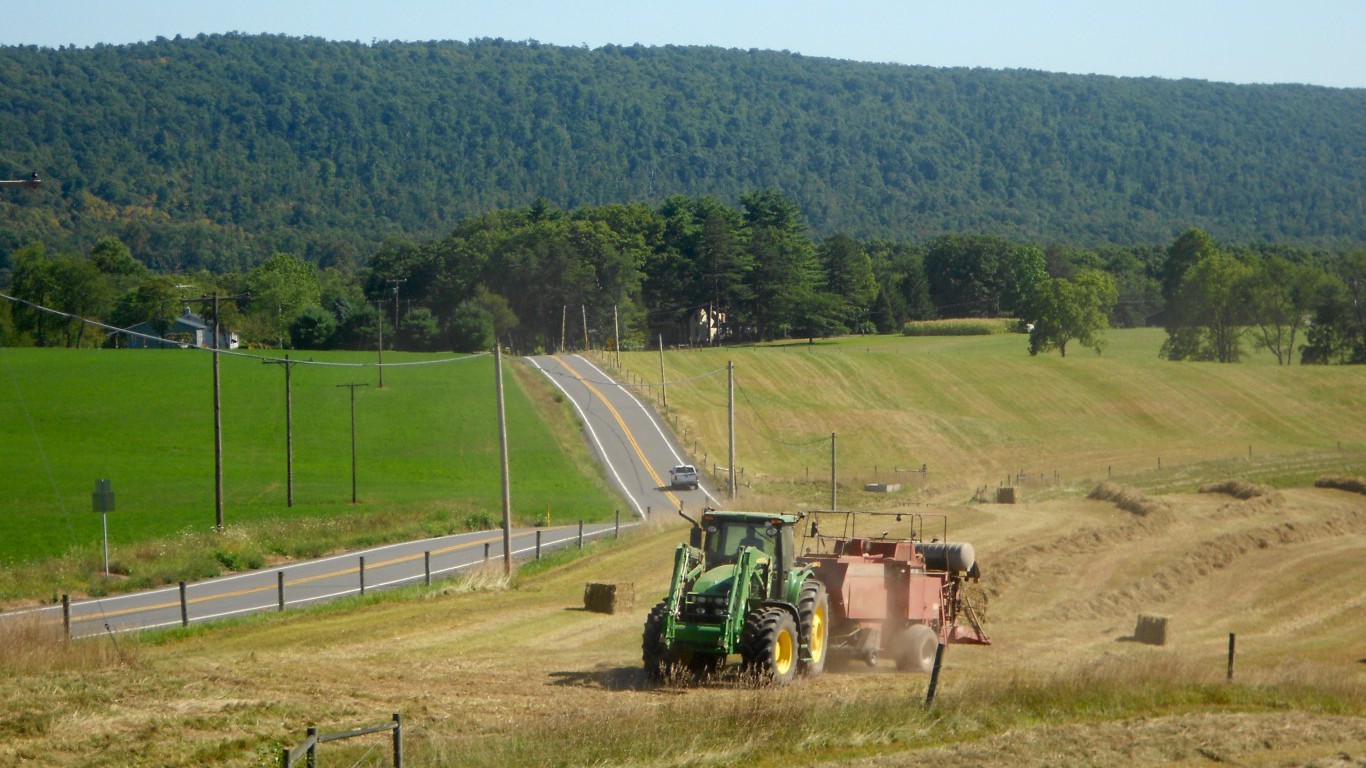
25. Fulton County, Pennsylvania
> Lyme disease cases 5 years through 2018 per 10,000 people: 114
> Lyme disease cases 5 years through 2018: 165
> Worst year for Lyme disease since 2000: 44 in 2016
> Total population: 14,506
Fulton County in southern Pennsylvania consists of a mountainous region in the Appalachian Ridge. Featuring a state park and a forest, the county is a popular destination for swimming, fishing, and hiking in the summer. Since 2009, Fulton County has been recording a total of about 30 Lyme disease cases a year, with three spikes in 2011, 2012, and 2016, when cases that year peaked at 44.
[in-text-ad]
24. Lincoln County, Maine
> Lyme disease cases 5 years through 2018 per 10,000 people: 114
> Lyme disease cases 5 years through 2018: 389
> Worst year for Lyme disease since 2000: 98 in 2016
> Total population: 34,067
Lincoln is a coastal county in Maine that includes several islands and rivers as well as the Damariscotta Lake State Park and over a dozen nature preserves that include forests, fields, and bogs — landscapes all known to harbor deer ticks. Lincoln County has consistently recorded more than 50 Lyme disease cases a year since 2011, reaching a peak at 98 in 2016.
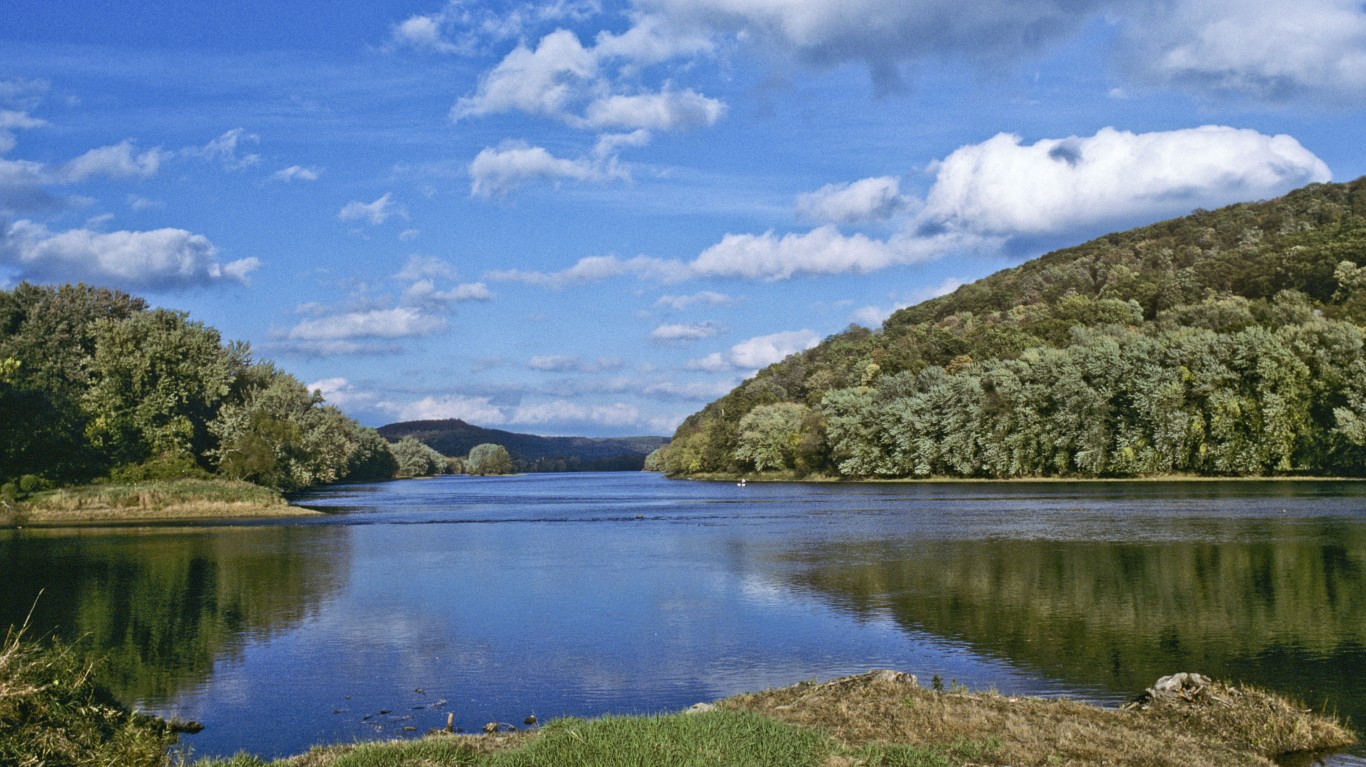
23. Venango County, Pennsylvania
> Lyme disease cases 5 years through 2018 per 10,000 people: 117
> Lyme disease cases 5 years through 2018: 614
> Worst year for Lyme disease since 2000: 168 in 2016
> Total population: 52,376
Between 2000 and 2018, the latest year for which data is available, Venango County in northeastern Pennsylvania recorded two spikes of Lyme disease cases. In 2014, the total number of reported infections more than doubled from 23 the previous year to 59. The second surge was recorded two years later, when cases nearly doubled from 87 in 2015 to 168 in 2016. The total number of reported Lyme disease cases has remained higher than previous years.
22. Warren County, New Jersey
> Lyme disease cases 5 years through 2018 per 10,000 people: 118
> Lyme disease cases 5 years through 2018: 1,257
> Worst year for Lyme disease since 2000: 393 in 2017
> Total population: 106,293
Warren County, which borders Pennsylvania, is a rugged and hilly terrain that includes the Kittatinny Ridge. The Delaware River, which has a total shoreline in the county of 52 miles, is a hotspot for recreational activities. There have been at least 100 cases of Lyme disease reported every year since 2000. The worst year has been 2017, when a total of 393 cases were confirmed. This is about a quarter more than the second worst year, when 292 cases were reported in 2009.
[in-text-ad-2]
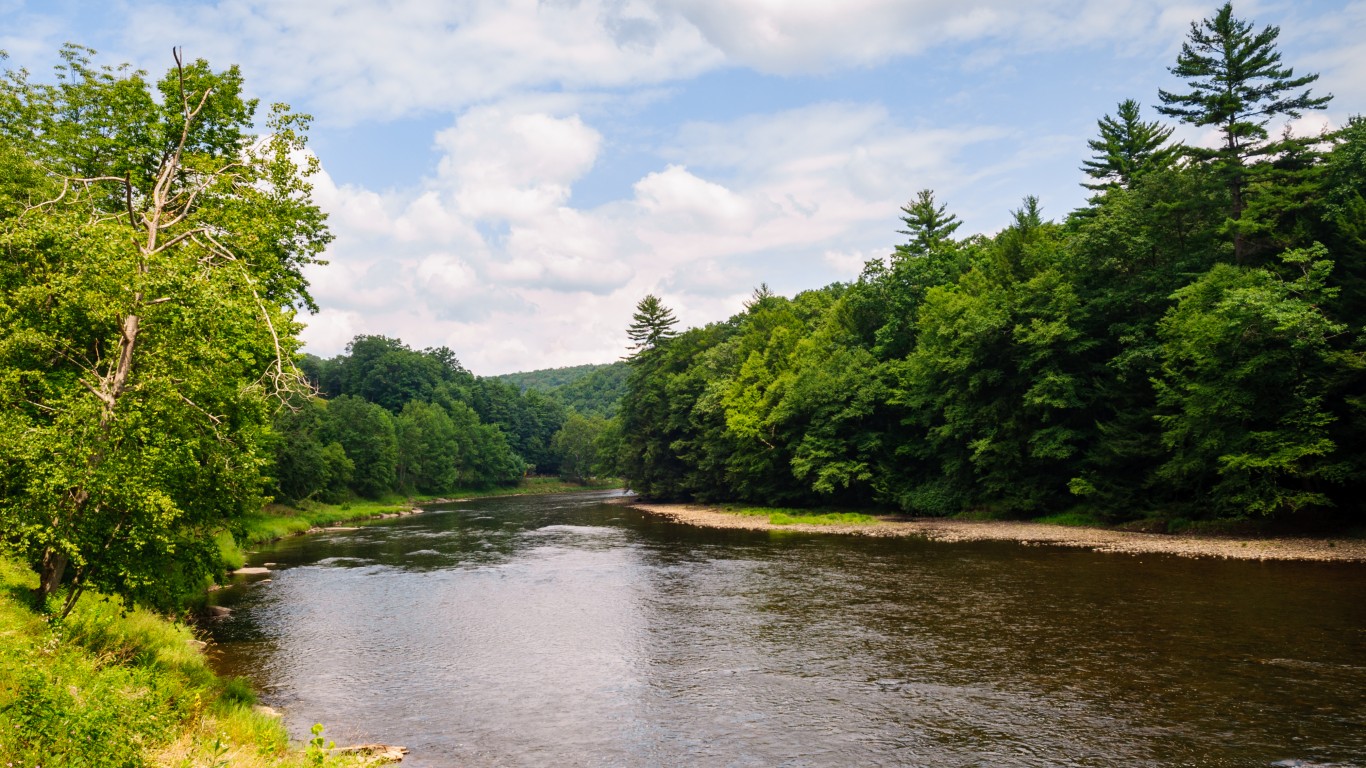
21. Forest County, Pennsylvania
> Lyme disease cases 5 years through 2018 per 10,000 people: 118
> Lyme disease cases 5 years through 2018: 87
> Worst year for Lyme disease since 2000: 30 in 2017
> Total population: 7,351
Forest County, one of 22 Pennsylvania counties on this list, has the third smallest population of all counties in the state, with just over 7,300 residents. That may explain why a county with relatively few total number of reported Lyme disease cases is high on the list. Though there were only 317 reported cases between 2014 and 2018, peaking at 30 in 2017, the rate of Lyme disease cases in that period was 118 per 10,000 residents.
20. Washburn County, Wisconsin
> Lyme disease cases 5 years through 2018 per 10,000 people: 119
> Lyme disease cases 5 years through 2018: 187
> Worst year for Lyme disease since 2000: 69 in 2010
> Total population: 15,689
Washburn County, Wisconsin, has the highest rate of Lyme disease per capita of all the worst counties in the Midwestern hotspots of Wisconsin and Minnesota. With a population of 15,689, the county recorded a total of 753 cases from 2000 to 2018, or 480 cases per 10,000 people over that time.
[in-text-ad]
19. Wyoming County, Pennsylvania
> Lyme disease cases 5 years through 2018 per 10,000 people: 120
> Lyme disease cases 5 years through 2018: 331
> Worst year for Lyme disease since 2000: 99 in 2017
> Total population: 27,588
Wyoming County, which has a population of about 28,000 people, is one of seven entirely rural counties in the state. Located in northeastern Pennsylvania, a hilly and forested region, the county has not had more than 100 Lyme disease cases reported a year since 2000. The worst year was 2017, when a total of 99 infections were confirmed. The following year, the number dropped to 50.
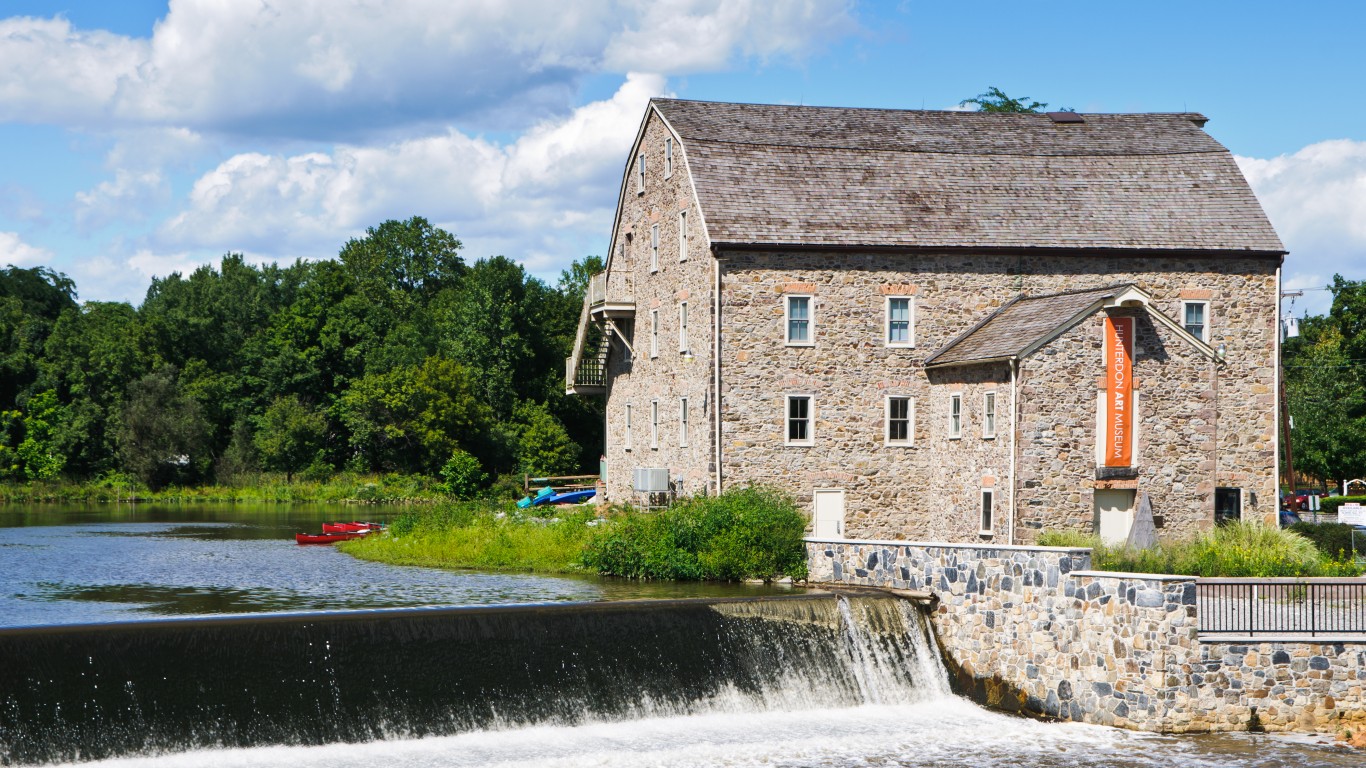
18. Hunterdon County, New Jersey
> Lyme disease cases 5 years through 2018 per 10,000 people: 123
> Lyme disease cases 5 years through 2018: 1,534
> Worst year for Lyme disease since 2000: 538 in 2000
> Total population: 125,051
Hunterdon County, New Jersey, reported 538 cases in 2000, ranking seventh that year among the counties with the highest cases of Lyme disease in the country. From 2000 to 2018, 6,618 cases were reported — the second highest total of all the worst counties for Lyme disease. Although the numbers were initially high, cases have decreased.

17. Huntingdon County, Pennsylvania
> Lyme disease cases 5 years through 2018 per 10,000 people: 123
> Lyme disease cases 5 years through 2018: 558
> Worst year for Lyme disease since 2000: 166 in 2016
> Total population: 45,421
Huntington County is located in central Pennsylvania, a mountainous region in the Appalachian Ridge. The county is home to several state parks that are popular swimming, fishing, and hiking destinations. Between 2000 and 2018, the latest year for which data is available, there have been only two years when the total number of reported Lyme disease cases exceeded 100 — peaking at 166 in 2016 and in 2017 with 143.
[in-text-ad-2]
16. Galax City, Virginia
> Lyme disease cases 5 years through 2018 per 10,000 people: 124
> Lyme disease cases 5 years through 2018: 82
> Worst year for Lyme disease since 2000: 28 in 2017
> Total population: 6,638
With a small population of 6,638, Galax City, which is considered a county equivalent, in southwestern Virginia has a relatively high number of Lyme cases, and numbers have only recently grown. Galax had no cases from 2000 to 2006 and only a total of five reported cases from 2007 to 2013. Cases have increased in the last five years, with 82 total reported between 2014 and 2018.
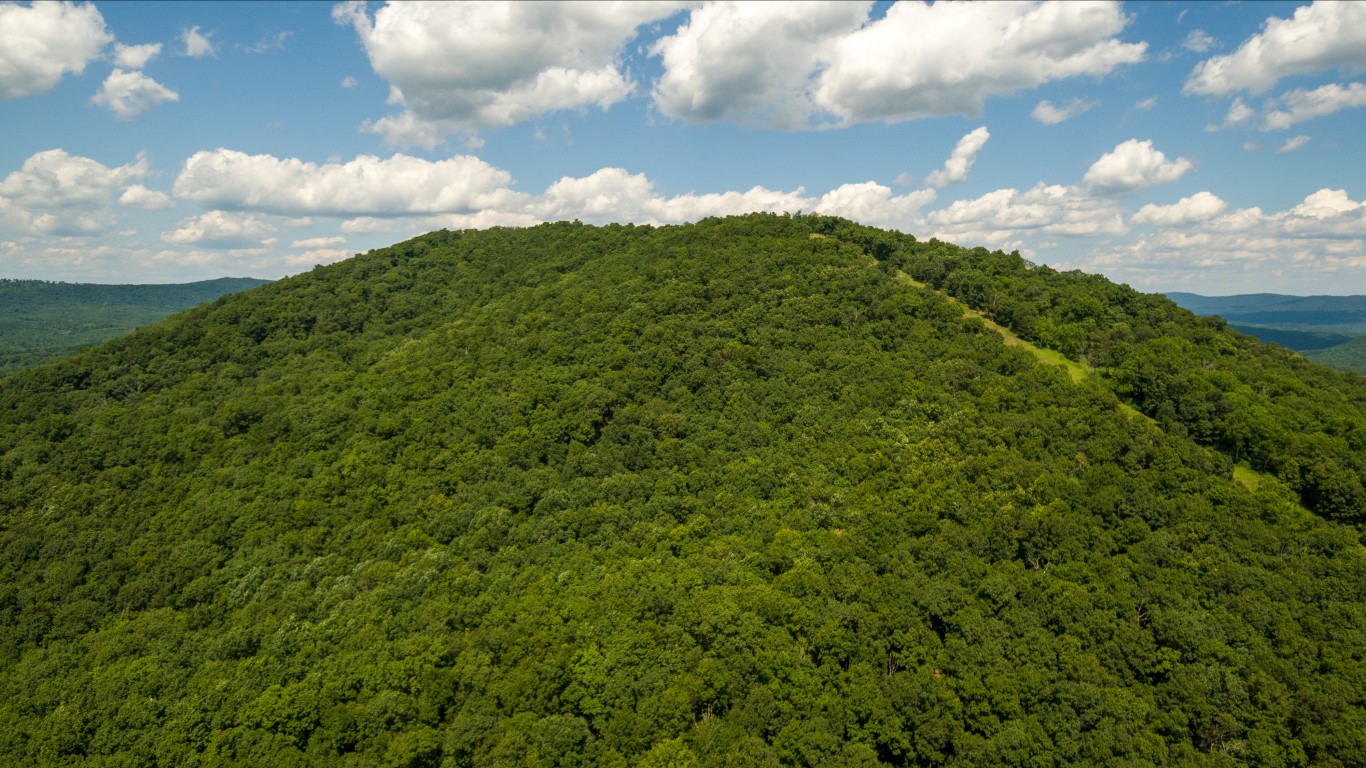
15. Bedford County, Pennsylvania
> Lyme disease cases 5 years through 2018 per 10,000 people: 129
> Lyme disease cases 5 years through 2018: 629
> Worst year for Lyme disease since 2000: 175 in 2017
> Total population: 48,611
Bedford County is a mountainous region lying mostly in the Appalachian Ridge located in southern Pennsylvania. Biking and hiking, especially in the Blue Knob State Park, the county’s “Big Mountain” park, are popular outdoor activities. Though a total of 629 Lyme disease cases were reported in the county between 2014 and 2018, the 90th highest total of the 3,145 counties in the CDC surveillance data, most of them were reported in 2016 (171 cases) and 2017 (175 cases).
[in-text-ad]
14. Elk County, Pennsylvania
> Lyme disease cases 5 years through 2018 per 10,000 people: 131
> Lyme disease cases 5 years through 2018: 400
> Worst year for Lyme disease since 2000: 116 in 2013
> Total population: 30,608
Elk County in northwestern Pennsylvania is a mountainous region that consists of many rolling hills. The county includes in its boundaries Elk and Bendigo state parks as well as a portion of the Allegheny National Forest. Unlike most counties in Pennsylvania that are on this list, Elk County has reported a steady number of Lyme disease cases a year since 2008 — between 60 and 80 — with two spikes in 2013 and 2016, when there were 116 and 113 reported cases, respectively.
13. Greene County, New York
> Lyme disease cases 5 years through 2018 per 10,000 people: 132
> Lyme disease cases 5 years through 2018: 629
> Worst year for Lyme disease since 2000: 313 in 2008
> Total population: 47,617
Although New York state is a hotspot for Lyme disease and many New York counties see hundreds of cases a year, only two counties in the state rank among the worst 50 in the country. Greene County’s disease infection rate from 2000 to 2018 was 587 cases per 10,000 people, making it the fourth worst county for Lyme disease overall during that span of years.

12. Bradford County, Pennsylvania
> Lyme disease cases 5 years through 2018 per 10,000 people: 136
> Lyme disease cases 5 years through 2018: 834
> Worst year for Lyme disease since 2000: 245 in 2017
> Total population: 61,304
Bradford County is located in northern Pennsylvania and borders New York state. The county consists of rugged hills and is a popular destination for many outdoor recreational activities, including hunting and fishing. Between 2000 and 2010, the county recorded no more than 13 Lyme disease cases a year. Since then, however, the number of cases has spiked, reaching a peak of 245 in 2017.
[in-text-ad-2]
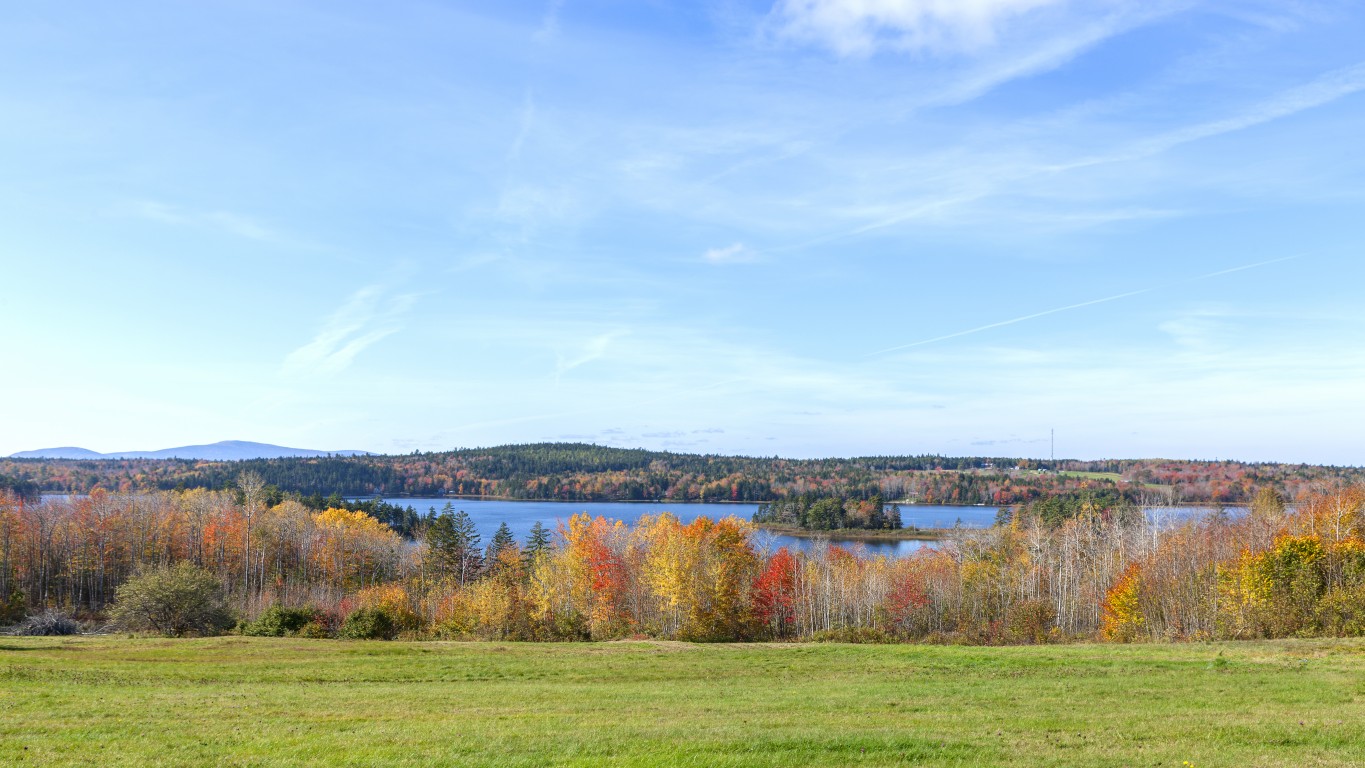
11. Hancock County, Maine
> Lyme disease cases 5 years through 2018 per 10,000 people: 141
> Lyme disease cases 5 years through 2018: 768
> Worst year for Lyme disease since 2000: 204 in 2017
> Total population: 54,541
Hancock County, Maine, consists of several forested islands and coastal areas in addition to forested inland areas dotted with lakes. The county includes multiple state recreation areas and the popular Acadia National Park. The county recorded at least 120 cases per year from 2014 to 2018, the last year for which data is available.
10. Knox County, Maine
> Lyme disease cases 5 years through 2018 per 10,000 people: 144
> Lyme disease cases 5 years through 2018: 575
> Worst year for Lyme disease since 2000: 145 in 2017
> Total population: 39,823
Knox County, home to nearly 40,000 people, is located in southern Maine and includes about 20 islands, including the popular Vinalhaven Island and Isle Au Hait. Most notably, the county includes parts of Acadia National Park as well as Camden Hill State Park, both of which are blanketed with forests. The county, one of six Maine counties on the list, had a sharp increase in cases of Lyme disease in 2008, when 72 were reported, up from 21 in 2007. There have been more than 100 cases of Lyme disease reported every year since 2014, peaking at 145 in 2017.
[in-text-ad]

9. Butler County, Pennsylvania
> Lyme disease cases 5 years through 2018 per 10,000 people: 149
> Lyme disease cases 5 years through 2018: 2,771
> Worst year for Lyme disease since 2000: 658 in 2017
> Total population: 186,566
Butler County, Pennsylvania, has the highest population as well as the highest five-year total of Lyme disease cases among the 50 worst counties for Lyme disease. The county reported 658 cases in 2017, which was the record year for many counties possibly due to a bumper crop of acorns in the Northeast that led to a mouse population boom.
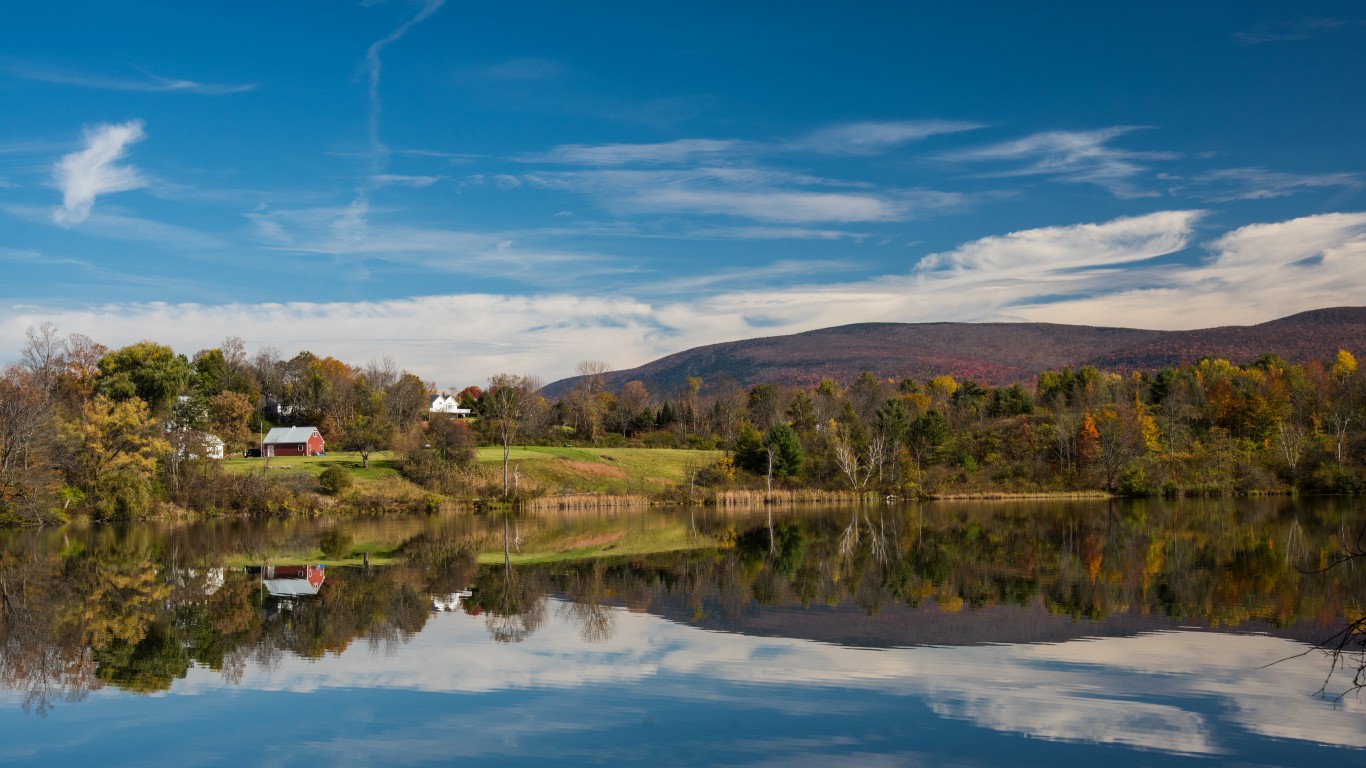
8. Bennington County, Vermont
> Lyme disease cases 5 years through 2018 per 10,000 people: 161
> Lyme disease cases 5 years through 2018: 578
> Worst year for Lyme disease since 2000: 174 in 2011
> Total population: 35,920
Of the five counties in Vermont that rank among the worst for Lyme disease, Bennington County has the second-smallest population but the most cases when adjusted to population. Most of the county consists of public land belonging to the Green Mountain National Forest and is heavily wooded. According to the County Health Rankings, 100% of the county’s residents have access to exercise opportunities.
7. Columbia County, New York
> Lyme disease cases 5 years through 2018 per 10,000 people: 163
> Lyme disease cases 5 years through 2018: 991
> Worst year for Lyme disease since 2000: 999 in 2002
> Total population: 60,919
From 2000 to 2018, Columbia County, New York, located south of Albany, recorded 7,392 cases of Lyme disease. That’s more than any other of the 50 worst counties. Following the high number of cases in the early 2000s, which peaked at 999 cases in 2002, Columbia’s reported Lyme disease cases have dramatically decreased, with only 129 cases reported in 2018.
[in-text-ad-2]

6. Armstrong County, Pennsylvania
> Lyme disease cases 5 years through 2018 per 10,000 people: 163
> Lyme disease cases 5 years through 2018: 1,084
> Worst year for Lyme disease since 2000: 268 in 2016
> Total population: 66,331
Armstrong County is next to several Pennsylvania counties that rank among the worst for Lyme disease, including Clarion to the north, Jefferson to the northeast, Venango to the northeast, and Butler to the west. The total number of Lyme disease cases increased sharply in 2011, when 146 cases were confirmed, doubling from 73 the previous year. Every year since 2015 there have been more than 200 cases of the disease in Pennsylvania, peaking in 2016 with 268 confirmed Lyme disease cases.
5. Floyd County, Virginia
> Lyme disease cases 5 years through 2018 per 10,000 people: 165
> Lyme disease cases 5 years through 2018: 259
> Worst year for Lyme disease since 2000: 73 in 2016
> Total population: 15,666
Only two counties in Virginia made the list. Floyd County, which lies in the Blue Ridge Mountains, has the fifth highest rate of Lyme disease when adjusted to population. Although no cases were reported from 2000 to 2006, the number of cases began to slowly climb starting in 2007, reaching 50 cases in 2013 and peaking at 73 in 2016.
[in-text-ad]
4. Clearfield County, Pennsylvania
> Lyme disease cases 5 years through 2018 per 10,000 people: 180
> Lyme disease cases 5 years through 2018: 1,441
> Worst year for Lyme disease since 2000: 348 in 2016
> Total population: 80,216
Clearfield County, the third largest in the state by land area, is located in central Pennsylvania. It’s a mountainous county covered in state parks, a forest, and many waterways, including Treasure Lake as well as the Curwensville and Du Bois reservoirs. As of 2019, about 80,000 people lived in Clearfield County, which had the fourth highest rate of reported Lyme disease cases between 2014 and 2018 â 180 cases per 10,000 people. The county first recorded more than 100 annual cases of Lyme in 2009, with cases peaking at 348 in 2016.
3. Clarion County, Pennsylvania
> Lyme disease cases 5 years through 2018 per 10,000 people: 207
> Lyme disease cases 5 years through 2018: 805
> Worst year for Lyme disease since 2000: 206 in 2016
> Total population: 38,827
Clarion County, a county in northwestern Pennsylvania with a population of about 40,000 people, is a hilly region on the Allegheny Plateau, divided by the Clarion River, with forest-covered mountains everywhere you turn. The county includes part of the Cook Forest State Park. The number of Lyme disease cases in the county has skyrocketed since 2000, when only one case was reported. In 2016, there were 206 Lyme disease cases.
2. Cameron County, Pennsylvania
> Lyme disease cases 5 years through 2018 per 10,000 people: 233
> Lyme disease cases 5 years through 2018: 109
> Worst year for Lyme disease since 2000: 28 in 2016
> Total population: 4,686
Cameron County, Pennsylvania is the state’s least populous county. With a relatively small population of 4,686, it nevertheless has the second highest reported rate of Lyme disease in the country when adjusted to population. Cameron County is known as an outdoor destination, with 97% of land area being forested, and it is home to multiple state-owned recreational areas.
[in-text-ad-2]
1. Jefferson County, Pennsylvania
> Lyme disease cases 5 years through 2018 per 10,000 people: 240
> Lyme disease cases 5 years through 2018: 1,056
> Worst year for Lyme disease since 2000: 290 in 2017
> Total population: 44,084
Of the 50 worst counties for Lyme disease, 22 are in Pennsylvania, with Jefferson County leading as the worst county for Lyme disease in the country. From only one case in 2000 to 212 cases in 2018, Lyme disease cases have risen almost every year, with a peak of 290 reported cases in 2017.
Choosing the right (or wrong) time to claim Social Security can dramatically change your retirement. So, before making one of the biggest decisions of your financial life, it’s a smart idea to get an extra set of eyes on your complete financial situation.
A financial advisor can help you decide the right Social Security option for you and your family. Finding a qualified financial advisor doesn’t have to be hard. SmartAsset’s free tool matches you with up to three financial advisors who serve your area, and you can interview your advisor matches at no cost to decide which one is right for you.
Click here to match with up to 3 financial pros who would be excited to help you optimize your Social Security outcomes.
Have questions about retirement or personal finance? Email us at [email protected]!
By emailing your questions to 24/7 Wall St., you agree to have them published anonymously on a673b.bigscoots-temp.com.
By submitting your story, you understand and agree that we may use your story, or versions of it, in all media and platforms, including via third parties.
Thank you for reading! Have some feedback for us?
Contact the 24/7 Wall St. editorial team.